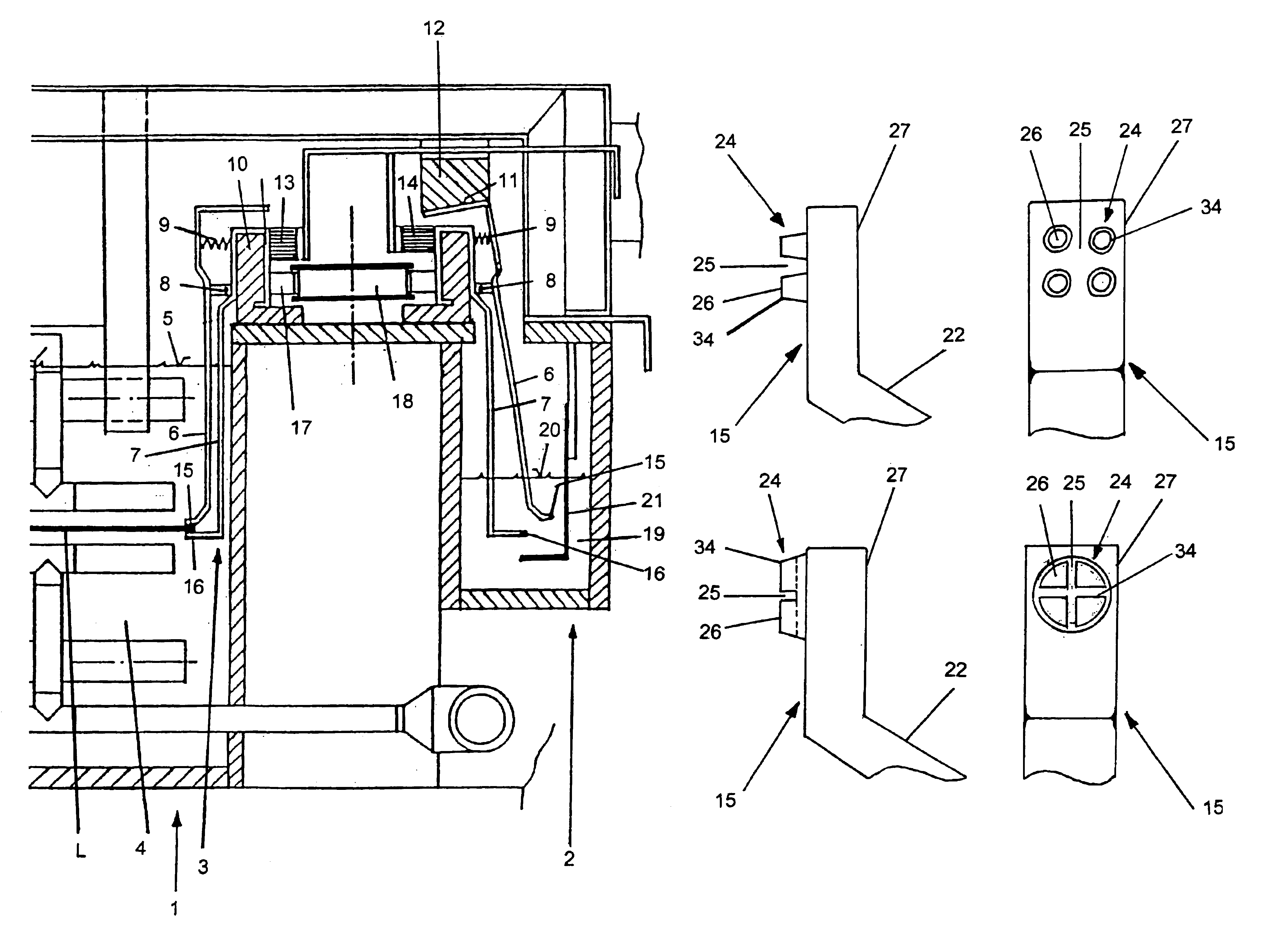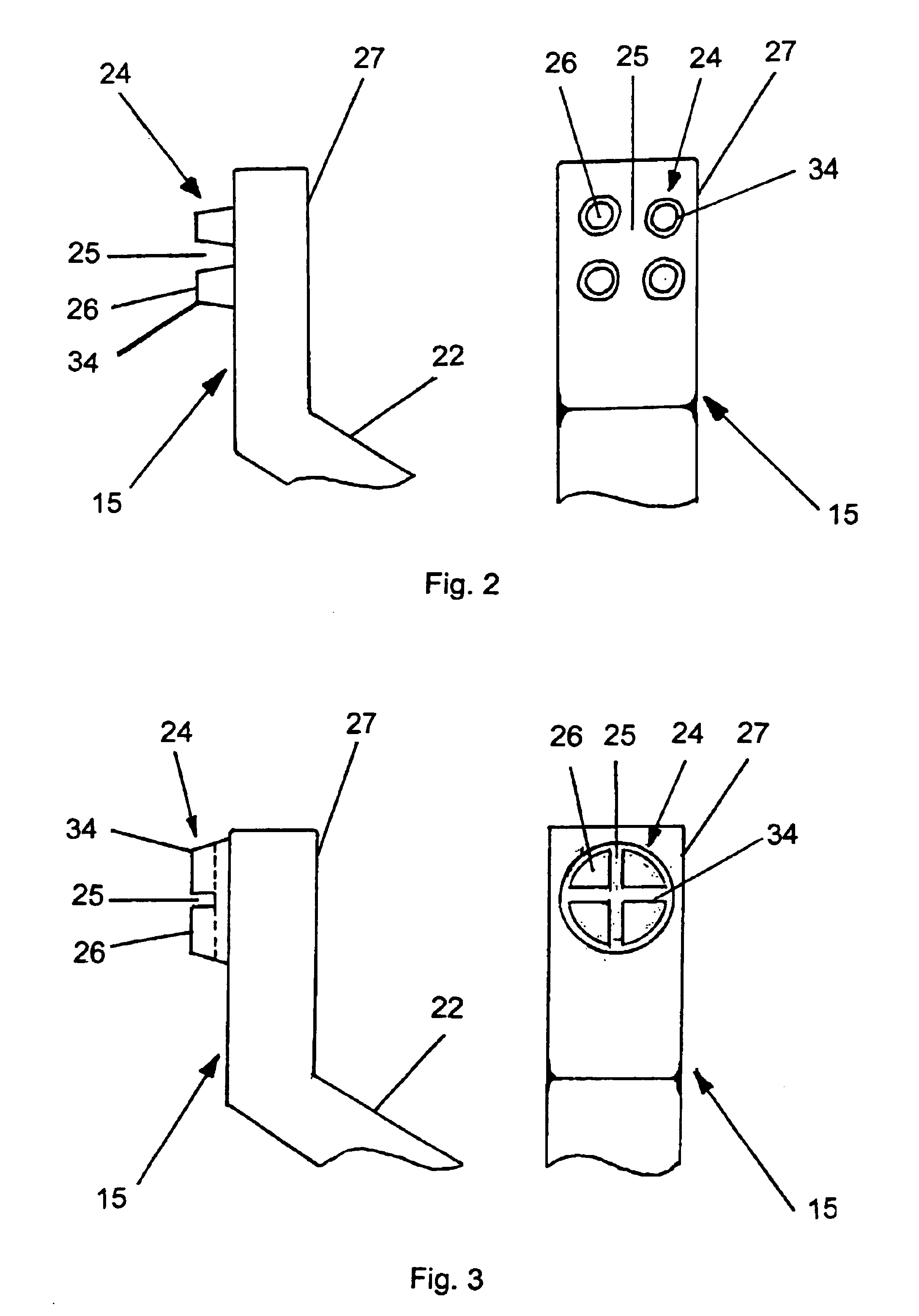Contact element for use in electroplating
a contact element and electroplating technology, applied in the field of contact elements, can solve the problems of difficult practical solutions, large currents that cannot be transmitted onto the thin conductive base coating of the device is not suited for transmitting large electric currents to the printed circuit board, so as to improve the cooling effect, and reduce the effect of heat generation
- Summary
- Abstract
- Description
- Claims
- Application Information
AI Technical Summary
Benefits of technology
Problems solved by technology
Method used
Image
Examples
first embodiment
[0060]a contact element 15 according to the invention is shown in FIG. 2. The contact element 15 is fastened to the stem 22 of the external clamp bar 6. The contact element 16 (not here presented) is fastened to the stem 23 of the internal clamp bar 7 in like manner. The contact elements 15, 16 substantially consist of a contact foot 27 and of the humps 24 fastened there onto with intervals 25 provided in between. Four humps 24 are provided in this embodiment, said humps being arranged on the corners of a square. On one side the contact humps 24 are provided with contact areas 26 which are delimited by the boundary line 34. On closing the clamp 3, the contact areas 26 are printed, i.e. pressed, very strongly on corresponding contacting areas on the surfaces of the printed circuit boards. The planarity of the contact areas 26 permits to achieve an intimate electrical contact with very little contact resistance between the contact areas of the humps 24 and the surfaces of the printed ...
second embodiment
[0062]the contacts is illustrated in FIG. 3. In this case too, the contact elements 15 (16 not shown) consist of the contact foot 27 and of the humps 24 arranged on said contact foot 27. In this case, the humps 24 are produced out of a circular surface in which grooves 25 are cut, which form the intervals between the humps 24. In this case there are two right-angled grooves 25 which subdivide the originally circular surface into four symmetrically arranged humps 24, each having the shape of a segment of a circle. In this case as well the various humps 24 are provided on one side with contact areas 26 which are delimited by the boundary line 34.
third embodiment
[0063]FIG. 4 indicates a third embodiment for the contacts. In this case, the contact foot 27 of the contact elements 15 (16 not shown) has an elongate shape. The various humps 24 are arranged in a row-shaped matrix and are produced by cuttings that simultaneously form the intervals (grooves) 25. The humps 24 are again provided on one side with plane contact areas 26 which are delimited by the boundary line 34.
[0064]The elongate shape of the hump arrangement allows a large supporting surface to be formed on a very narrow galvanoedge, a large enough contact surface F being available at the same time. As a result, the width of the useless galvanoedge may be further reduced.
[0065]The embodiments of FIGS. 2-4 are illustrative of embodiments of the present invention wherein the shape of the contact areas 26 is designed in such a way that the ratio V of the square of the overall length L of all boundary lines 34 to the size F of all the contact areas 26 as given by the expression: V=L2F
is...
PUM
| Property | Measurement | Unit |
|---|---|---|
| Electrical conductivity | aaaaa | aaaaa |
| Electrical resistance | aaaaa | aaaaa |
| Current | aaaaa | aaaaa |
Abstract
Description
Claims
Application Information
 Login to View More
Login to View More - R&D
- Intellectual Property
- Life Sciences
- Materials
- Tech Scout
- Unparalleled Data Quality
- Higher Quality Content
- 60% Fewer Hallucinations
Browse by: Latest US Patents, China's latest patents, Technical Efficacy Thesaurus, Application Domain, Technology Topic, Popular Technical Reports.
© 2025 PatSnap. All rights reserved.Legal|Privacy policy|Modern Slavery Act Transparency Statement|Sitemap|About US| Contact US: help@patsnap.com



